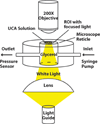Correlation of rupture dynamics to the nonlinear backscatter response from polymer-shelled ultrasound contrast agents
- PMID: 25935932
- PMCID: PMC4998738
- DOI: 10.1109/tuffc.2014.006828
Correlation of rupture dynamics to the nonlinear backscatter response from polymer-shelled ultrasound contrast agents
Abstract
Polymer-shelled ultrasound contrast agents (UCAs) may expel their encapsulated gas subject to ultrasound-induced shell buckling or rupture. Nonlinear oscillations of this gas bubble can produce a subharmonic component in the ultrasound backscatter. This study investigated the relationship between this gas-release mechanism and shell-thickness-to-radius ratios (STRRs) of polymer-shelled UCAs. Three types of polylactide-shelled UCAs with STRRs of 7.5, 40, and 100 nm/μm were studied. Each UCA population had a nominal mean diameter of 2 μm. UCAs were subjected to increasing static overpressure ranging from 2 to 330 kPa over a duration of 2 h in a custom-designed test chamber while being imaged using a 200× magnification video microscope at a frame rate of 5 frames/s. Digitized video images were binarized and processed to obtain the cross-sectional area of individual UCAs. Integration of the normalized cross-sectional area over normalized time, defined as buckling factor (Bf), provided a dimensionless parameter for quantifying and comparing the degree of pre-rupture buckling exhibited by the UCAs of different STRRs in response to overpressure. The UCAs with an STRR of 7.5 nm/μm exhibited a distinct shell-buckling phase before shell rupture (Bf < 1), whereas the UCAs with higher STRRs (40 and 100 nm/μm) did not undergo significant prerupture buckling (Bf ≈ 1). The difference in the overpressure response was correlated with the subharmonic response produced by these UCAs. When excited using 20-MHz ultrasound, individual UCAs (N = 3000) in populations that did not exhibit a buckling phase produced a subharmonic response that was an order of magnitude greater than the UCA population with a prominent pre-rupture buckling phase. These results indicate the mechanism of gas expulsion from these UCAs might be a relevant factor in determining the level of subharmonic response in response to high-frequency ultrasound.
Figures






References
-
- Ophir J, Parker KJ. Contrast agents in diagnostic ultrasound. Ultrasound Med. Biol. 1989;15(4):319–333. - PubMed
-
- Goldberg BB, Liu J, Forsberg F. Ultrasound contrast agents: A review. Ultrasound Med. Biol. 1994;20(4):319–333. - PubMed
-
- Goertz DE, Frijlink ME, de Jong N, van der Steen A. Nonlinear intravascular ultrasound contrast imaging. Ultrasound Med. Biol. 2006;32(4):491–502. - PubMed
-
- Bouakaz A, Frigstad S, Ten Cate FJ, de Jong N. Super harmonic imaging: A new imaging technique for improved contrast detection. Ultrasound Med. Biol. 2002;28(1):59–68. - PubMed
-
- Faez T, Emmer M, Docter M, Sijl J, Versluis M, de Jong N. Characterizing the subharmonic response of phospholipid-coated microbubbles for carotid imaging. Ultrasound Med. Biol. 2011;37(6):958–970. - PubMed
Publication types
MeSH terms
Substances
Grants and funding
LinkOut - more resources
Full Text Sources
Miscellaneous

